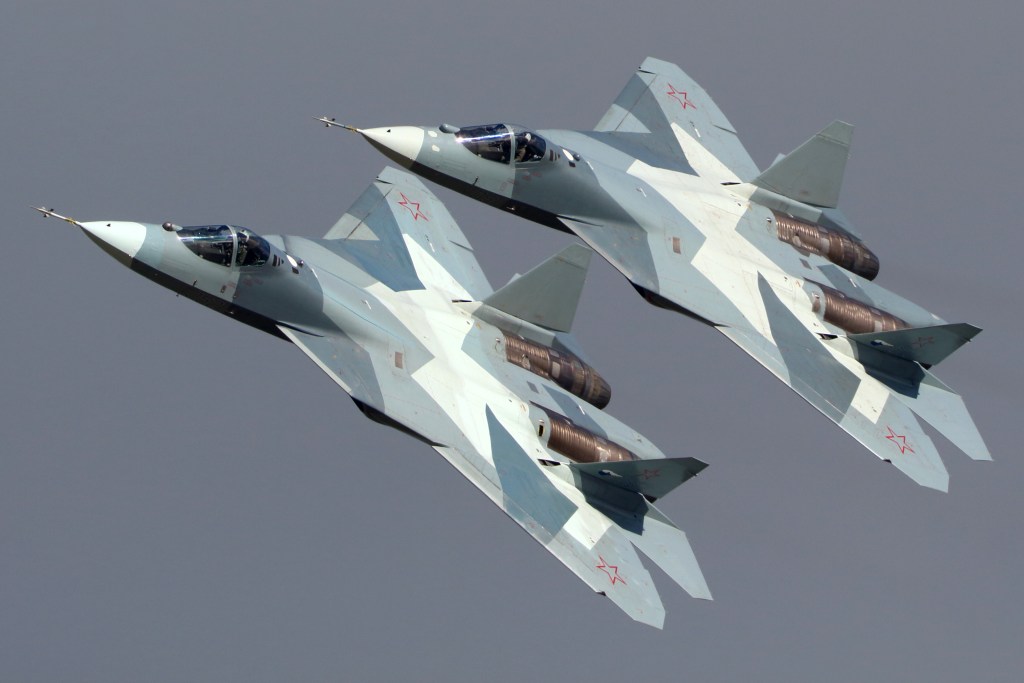When Russia first set to work on what would become the Sukhoi Su-57 (internally the T-50 at the time), it had a singular aim: utilizing 21st century stealth characteristics to produce a fighter capable of standing toe to toe with the best the United States had to offer, the F-35 Joint Strike Fighter and F-22 Raptor. On paper, even with Russia’s struggling economy, the endeavor prompted some concern due in large part to Russia’s history of fielding extremely maneuverable fighter platforms and an injection of funding sourced through a partnership with India.

Just how “stealth” is Russian stealth?
At the beginning of 2018, India pulled out of their development agreement with Russia. According to unconfirmed reports out of India, the decision was largely influenced by the new fighter failing to meet discussed standards regarding its stealth capabilities and avionics. Images of Russia’s few existing Su-57s show contour gaps in the body components that a number of experts contend compromise the aircraft’s stealth profile right from the start. It’s believed that Russia simply lacks the production capability to build these aircraft with tight enough tolerances to achieve F-35 or comparable levels of stealth.
There is also little evidence to suggest that Russia’s radar-absorbant coatings are as functional as the coating applied to American stealth aircraft. America has a decades-long head start in research and development on this front, offering what may be a significant difference in both performance and durability—though to be perfectly clear, any conclusions drawn in this regard are conjecture at best.

Engine troubles compromise the fighter’s range and performance.
The problems don’t end there for the Su-57. Thus far, all but one fighter has been built using two dated NPO Saturn Izdeliye 117 engines, which are effectively an updated version of the power plants utilized in Russia’s highly capable fourth-generation Su-35. These engines fail to meet the generally accepted guidelines for a fighter to qualify as a fifth-generation platform, which most agree must allow for “super cruising.” Super cruising involves maintaining supersonic speeds without keeping your afterburner engaged; it means covering far more territory much more quickly without sacrificing the fuel needed for the fight once you arrive. To date, only America’s F-22 Raptor and F-35 Joint Strike Fighter possess this capability in operational fifth-generation platforms, though both Russia and China continually claim their jets will meet that standard sometime soon.

Russia only has a single aircraft that actually meets fifth-generation standards.
Even disregarding a litany of other issues, there’s one statistic that truly damns Russia’s Su-57: how few are going to be made. Russia recently announced production of the 13 serialized fighters is being postponed until 2020, with delivery anticipated in 2023. That delivery date, however, is based on the continued use of the legacy 117 engines, meaning Russia will continue to have maybe one flyable fighter that truly meets the fifth-generation standard well into the 2020s, with only a dozen or so less-capable clones parked alongside it.
In contrast, America and its allies have already received some 360 F-35 Joint Strike Fighters and America alone possesses a fleet of 170 F-22 Raptors—widely believed to be the most capable air-superiority fighter on the planet thanks to a combination of speed, maneuverability, and low observability.

What does the Su-57 offer Russia?
Despite lacking the engine performance and stealth characteristics of a truly fifth-generation fighter and only being built in numbers so low these planes belong in a museum, the Su-57 program isn’t only bad news for the Russian government. The Su-57 garners headline after headline in the international press, with some outlets even claiming that painting a single F-16 aggressor with a color scheme that matches the Su-57 could somehow offer the United States an advantage in air warfare that would almost certainly involve very few appearances of said aircraft. In effect, the media has been the Su-57’s most powerful proponent, giving the world a sense that Russia is keeping pace with nations like the United States despite what objectively could be considered a failure to do so.
The aircraft itself also provided Russia with important experience in trying to develop and build a stealth platform. In no uncertain terms, these sorts of endeavors are how a nation develops a robust and capable stealth program, so although the Su-57 itself may not have a prominent future, the seeds of this program can still germinate into future, more successful, stealth endeavors. For now, any Su-57s Russia does build can serve as technology test beds, and can even offer Russia’s advanced fourth-generation fighters a competitive look unlike any other fighter in their fleet.
In short, the fighter may be a strategic failure, but it’s been a resounding PR success with other benefits potentially reverberating throughout Russian defense initiatives for years to come.
Feature image: Zhukovsky, Moscow Region, Russia – August 24, 2013: Sukhoi T-50 PAK-FA 052 BLUE in Zhukovsky during MAKS-2013
















